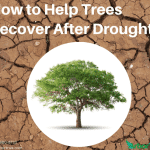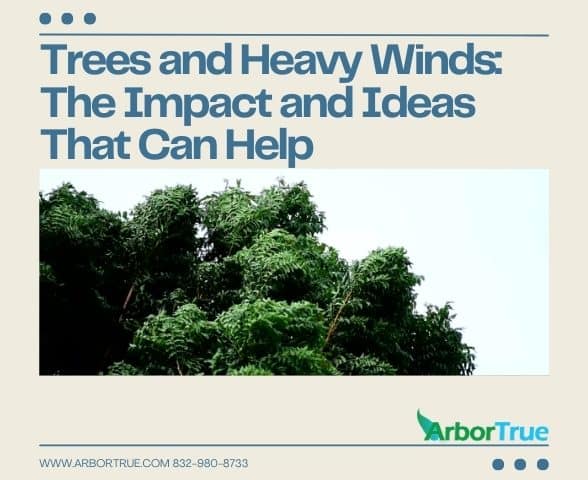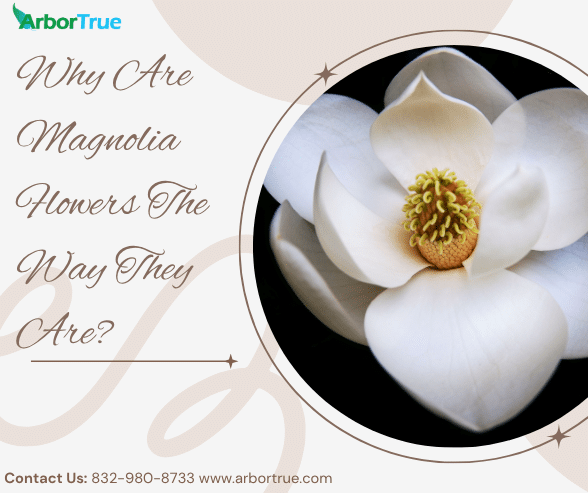
How to Help Trees Recover After Drought
August 14, 2024
Mushroom Monday: Blue Green Anise Mushroom (Clitocybe odora)
August 19, 2024
Trees and Heavy Winds: The Impact and Ideas That Can Help
High winds are a concern when it comes to trees. With the potential for fallen limbs and trees, damage, and injury, thinking about how high winds impact our trees is important. In today’s TrueTreeTalk blog post, we take a look at how high winds impact trees and ideas that can help you before and after high wind events.
How Do High Winds Impact Trees?
Of course, we all know that high winds can break tree limbs, cause trees to lean, and cause trees to fall. There are other impacts though that you might be less aware of.
High winds can cause a number of kinds of damage to trees. Winds can cause cracks, damage to vascular tissue, bending of a tree’s fibers, and leaves to blow away from the canopy. Winds that cause trees to move from the ground can cause their roots to stretch and break. This can make trees less stable and can decrease their ability to absorb water.
When thinking about the impact of high winds, one thing to note is that it is normal for a tree’s canopy to move in the wind. This movement can help the tree respond to the wind blowing on it. If a tree is brittle and its canopy doesn’t sway in the wind, it may be more likely to break.
In addition to the physical things we can see, winds can also have other impacts on trees. For example, winds can cause trees to lose heat in certain situations (in somewhat the same way we might feel cooler in a breeze). Winds can also impact how trees exchange gasses and winds can even cause trees to change their shape as they grow.
What are Some Things That Can Cause Trees to Have Greater Impacts from High Wind?
Not all trees in all situations are impacted by high winds equally. Different trees can respond very differently to the same winds depending on circumstances.
Tree Health
One important factor is tree health. All else being equal, if a tree is healthy it can potentially come out better after high winds than one that isn’t. An unhealthy tree, for example, might have decay which could weaken it structurally and make it more prone to breaking in high winds.
Roots
Another thing that can impact how a tree deals with high winds is the amount of space the tree has for its roots to grow. A tree that is grown in a place where its roots are restricted, for example an urban area surrounded by concrete, might be more likely to be toppled by the wind because it has less anchoring by its roots than a tree with sufficient root space. Generally, the deeper and wider a tree’s roots go, the more stable it will be.
Something else to look out for are roots that are girdling the tree. These can cause a number of issues and can weaken a tree over time. This can lead to a greater potential for damage in high winds.
Also, if a tree’s roots are in compacted or waterlogged soil, it too might be more likely to fall in a storm than a tree in better conditions.
Structure
The structure of a tree can also impact how it responds to winds. For example, a tree with codominant stems would be more likely to split, all else being equal, than a tree with a strong central leader. Also structural issues, such as poor pruning, can also have an impact.
Setting
Another factor that can influence how a tree responds to winds is whether or not it was previously surrounded by other trees. If trees were previously in a forest setting, but the trees around them were removed for something like construction, the remaining trees will have less protection from winds and might not have the proper growth to be able to deal with them. Trees like this might be more likely to fall in high winds than those still surrounded by other trees.
Species
The species a tree is can have an impact on how it responds to high winds. Trees with strong wood, deep roots, and flexibility in their branches, can have less potential to be damaged from high winds than those tree species that have the opposite characteristics.
Age and Condition
A tree’s age can have an impact on how it responds to high winds. If a tree is younger, its roots may be less developed and its wood weaker, and so it might sustain more damage than a more mature tree. If a tree is old though, and has issues such as disease or issues with its structure, it too might not do as well in a high wind event.
Ideas That Can Help Before and After High Winds
Below are a number of ideas that can help you help your trees either before or after a high wind event. Before an event, these ideas can help you mitigate some of the potential risks. After an event (after you have dealt with immediate concerns such as fallen trees), these ideas can help you to help your trees recover and can help you to mitigate some of the risks before the next event. These ideas can help you in a number of situations such as when your trees have experienced a high wind event, and you think they may have some issues, but aren’t sure. Of course, it is impossible to eliminate all risks, but these ideas can be a good first step in mitigating some of the potential ones. We had a recent blog post about hurricane preparedness, that also has useful information.
Arborist Consultation
An arborist consultation prior to the season for high winds in your area can be a great idea. Express your concerns about high winds impacting your trees and provide your arborist with as much information as you can about the history of your trees and their condition. An arborist can evaluate the health of your trees, inform you about risks related to high winds, and provide you with information and steps that can be taken.
Proper Planting
Above we noted that different species of tree can respond differently to high winds. By having trees planted that are more resistant to high winds, as well as those that are native or naturalized to your area, you can take a step to lessen the potential for something to occur with them during high winds.
When having trees planted, it is important that the soil not be compacted and that the trees have enough open space around them for them to reach their full size. Both of these things will promote the health of the trees and help them to be better able to stand up to future high winds.
Additionally, avoid planting trees too close to structures that the trees might impact, or that might be impacted by the trees. It is also important to plant trees the proper distance from power lines. Check with your utility company and for any regulations regarding this.
When planting trees, discuss with your arborist the pros and cons of staking. Although staking trees can be appropriate in some situations if done properly, in other situations it can be better to have newly planted trees acclimate to the winds they will face so that they can develop strongly. An arborist can advise you on what is best for your situation.
Maintenance
Proper maintenance can be essential for the overall health of your trees and can be an important step in helping to mitigate potential damage from high winds.
We mentioned above about having arborist consultations. An arborist can develop a maintenance plan that could include things such as treatment for pests, fungi, or disease, pruning, and fertilization. By following their plan, you can take steps to maintain the overall health of your trees.
One step you can take is to walk around periodically and look at your trees, note things of concern, and take photographs. Although you might not know all the things to look for, what you do document can help you communicate with your arborist when they do an inspection.
Additionally, proper watering can be important to maintaining the overall health of your trees and helping them to be able to withstand high winds. Watering your trees based on their needs (which an arborist can help you determine) can be better than watering based on a set schedule.
Pests can be a problem that can weaken a tree before a high wind event, and they can also be a problem after one as pests can be attracted to weakened trees. An arborist can inspect your trees for pest issues and can develop a plan for their treatment if needed and beneficial.
We’ve mentioned before the numerous benefits of mulch and how it can promote the overall health of your trees. If you don’t have mulch properly applied around your trees, having it applied can be a good step in promoting their overall health.
Pruning
Pruning can be an important part of maintenance for trees. By having dead, diseased, and damaged branches removed, the overall health of the tree can be promoted and it can have the potential to do better in high winds.
There are some other things about pruning you might want to discuss with your arborist. They include having strong angles for the branches on your trees, having the proper relationship between the size of branches and the trunk of your tree, helping the tree to have its weight centered, removing weak branches, not pruning away too much of the canopy, and generally proper pruning.
One thing that we’ve mentioned before is the idea that thinning the canopy of a tree to allow the wind to blow through during a storm, thereby preventing wind damage, is an incorrect idea. Thinning of this type can reduce the structural integrity of a tree and make it more prone to damage in the wind. Your arborist can explain more about this.
Above we mentioned that having codominant stems can be a risk factor during high winds. Depending on the situation, your arborist may recommend pruning of young trees to remove one of the codominant stems. In more mature trees, they may recommend cabling or bracing depending on the situation to mitigate some of the risks of having codominant stems.
Tree Removal
One way to lessen the potential for damage from high wind is to have dying, dead, or high risk trees removed before a high wind event. Dead and dying trees can have a number of issues and having these trees, as well as high risk ones, removed before a wind event will ensure there won’t be issues from them during a wind event.
One thing people often question is whether a tree that is leaning as a result of high winds can be straightened or not. Generally, it isn’t feasible to straighten a tree that is leaning as a result of high winds if the diameter of the tree’s trunk is more than four inches. The tree could have internal damage, the roots could be damaged, the soil could be compromised, and the tree could pose a hazard. Trying to straighten a tree like this would be difficult and expensive and might not produce the desired results. In these situations, it would be better to have the tree removed.
In the case of a smaller tree (less than four inches in diameter), an arborist can inspect it and let you know if it might be a candidate for straightening and staking, or whether it should be removed as well.
If you found learning about the impact of heavy winds and how to help your trees deal with them helpful, check out the other posts on our TrueTreeTalk blog. Also, follow us on Facebook to keep up with these and other posts.
* * *
ArborTrue is a science-based tree-service company in the greater Houston area. We also serve Austin and other parts of Central Texas. We provide a range of services including tree trimming, tree pruning, tree removal, tree planting, arborist consultations, and more. Call us today at 832-980-8733 (Houston) or at 512-546-3833 (Austin) or reach out to us online to schedule an appointment.




